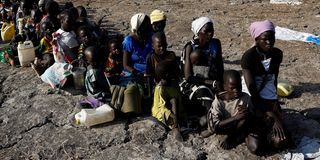
Women and children wait to be registered prior to a food distribution carried out by the United Nations World Food Programme (WFP) in Thonyor, Leer state, South Sudan on February 26, 2017. PHOTO | REUTERS
In the dusty, war-ravaged outskirts of North Darfur, a mother at the Zamzam camp cradles her emaciated child, her eyes hollow with exhaustion and fear. This is Fatima, a 32-year-old widow, who once led a simple but stable life, selling groceries in a local market in El Fasher, the besieged capital of her homeland in North Darfur.
Now she has become the depiction of Sudan’s hunger crisis where her camp has now reported famine, the impact of forfeited crop cultivation and subdued supplies from the ongoing war.
But Sudan’s 25.6 million people currently facing hunger aren’t the only group. New data says that even peaceful regions of the wider Horn of Africa are just in trouble, with the culprit being economic shocks and climate change that is causing erratic weather.
The Intergovernmental Authority on Development (Igad) Regional Focus of the 2024-Global Report on Food Crises, released on Thursday first assessed 14 areas, five localities and nine clusters of IDPs and refugees in Greater Darfur, Greater Kordofan, Al-Gazira State, and some hotspots in Khartoum in Sudan.
In the overall Horn of Africa, it shows some improvements in some countries like Kenya and Somalia. But even those improvements are overshadowed by worsening conditions elsewhere.
An estimated 755,300 people are projected to reach the critical Catastrophe (IPC Phase 5) stage during the lean season leading up to September, the most severe level of food insecurity, where individuals face extreme destitution, starvation, acute malnutrition, and a high risk of death after exhausting all their coping mechanisms.
The Report analysed seven of the eight Igad member states including Sudan. And the trends were similar to elsewhere in the world: conflict remains, the main driver of food crises, affecting the largest number of people.
“Last year, global conflict escalated, with particularly severe impacts in Sudan and Pakistan. Out of twenty countries where conflict was the main driver of food insecurity, Sudan, was most affected,” noted Sarah McHattie, Global Coordinator at the Food Security Information Network at the launch.
“Countries where conflict is a primary driver are not only more susceptible to food crises but also face increased vulnerability to economic and weather-related shocks.”
According to Igad’s regional focus on member states, acute food insecurity has worsened for the fifth consecutive year, primarily due to the conflict-driven humanitarian crisis in Sudan. Without this emergency, the hunger outlook was on a stable path to improvement, aided by positive developments in Kenya and Somalia.
In the Igad region, which includes Kenya, Uganda, Somalia, South Sudan, Sudan, Djibouti, Eritrea, and Ethiopia, approximately 62.9 million people—more than a quarter of the 287 million population—are expected to face high levels of acute food insecurity in 2024.
This marks an increase from 61.9 million, or 24 percent of the population, in 2023.
Sudan has the highest number of people facing severe acute food insecurity, with 25.6 million affected, followed by Ethiopia, with 21 to 22 million, and South Sudan, with 7.1 million. Ethiopia and South Sudan have carried the biggest burden of refugees from Sudan, among Igad countries. They both host at least 1 million of them in total even though they themselves are also recovering from conflict.
In contrast, improvements have been observed in Kenya, Somalia, and South Sudan, where the number of people experiencing acute food insecurity has decreased by 3.5 million, 2.6 million, and 0.6 million, respectively, compared to 2023.
Meanwhile, Ethiopia and Uganda are also seeing an increase in people facing high levels of acute food insecurity in 2024 compared to 2023, while South Sudan has slightly fewer, thanks to favorable 2023/24 harvests, in terms of prevalence, together with Sudan (54 percent), SS has the highest prevalence with well over half (56 percent) of their population in need of urgent food and livelihood assistance.
Four Igad member states—Ethiopia, Sudan, Somalia, and South Sudan—are among the ten countries with the highest numbers of acutely malnourished children.
“At the moment, 11.4 million children under the age of five years are estimated to be acutely nourished in the region. 2.8 million of them severely so.
High numbers of acutely malnourished children are found in Ethiopia with 4.1 million, and Sudan with 3.7 million, followed by Somalia, South Sudan, and Kenya,” said Charity Mumbua, a Statistics Specialist at ICPAK, during the launch of the report in Nairobi.
“While 3.9 million pregnant and lactating women are also estimated to suffer acute malnutrition in the region.”
Economic shocks, adverse macroeconomic conditions, characterised by local currency depreciation, low foreign currency reserves, a high public debt burden and volatile food prices are all blamed for the problem.
The Igad region has the highest number of forcibly displaced people globally in 2024, with 25.2 million, including 20.2 million internally displaced persons (IDPs) and 5 million refugees and asylum seekers. Sudan leads with 10.7 million IDPs, followed by Somalia (3.9 million) and Ethiopia (3.7 million).






